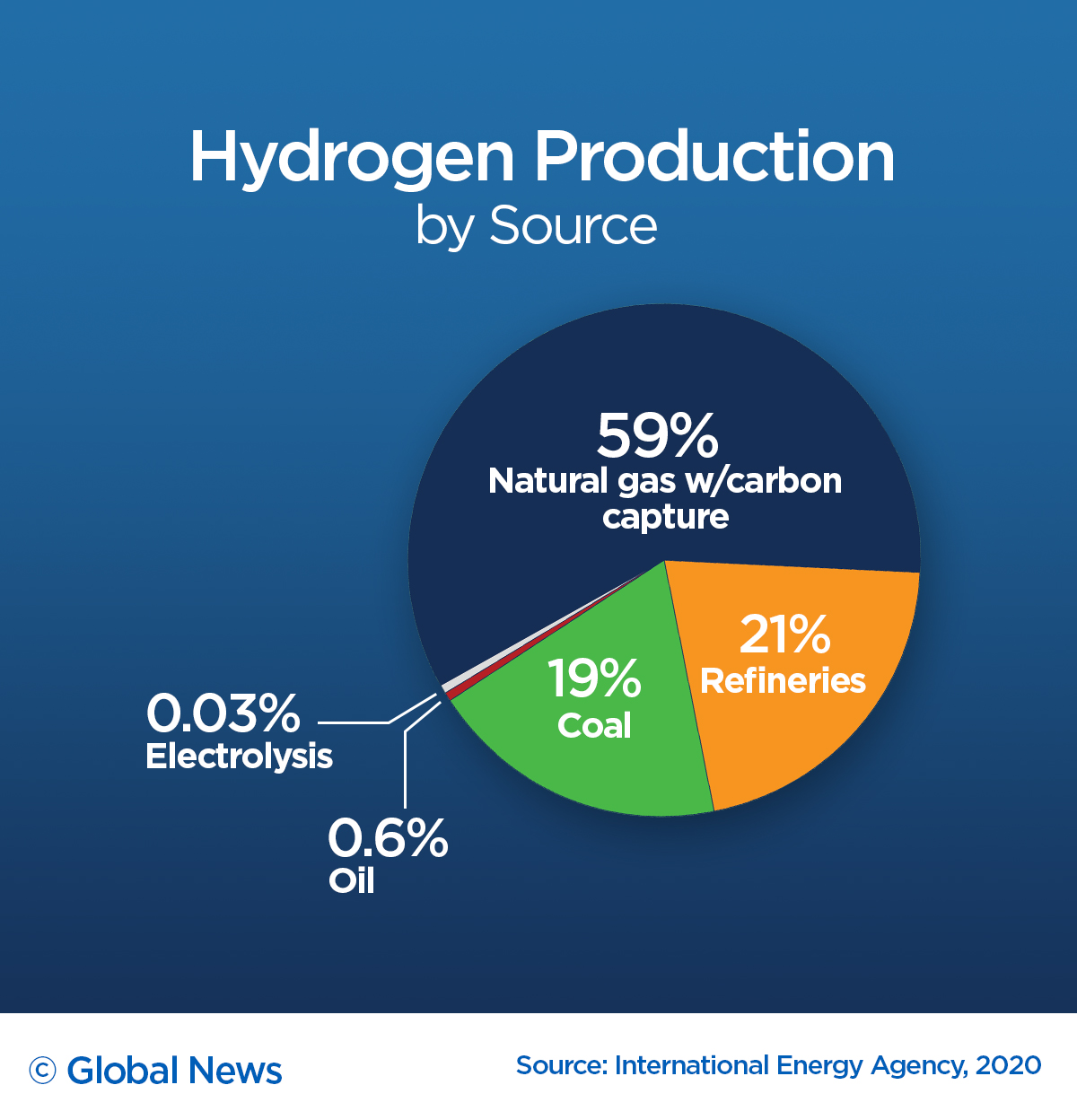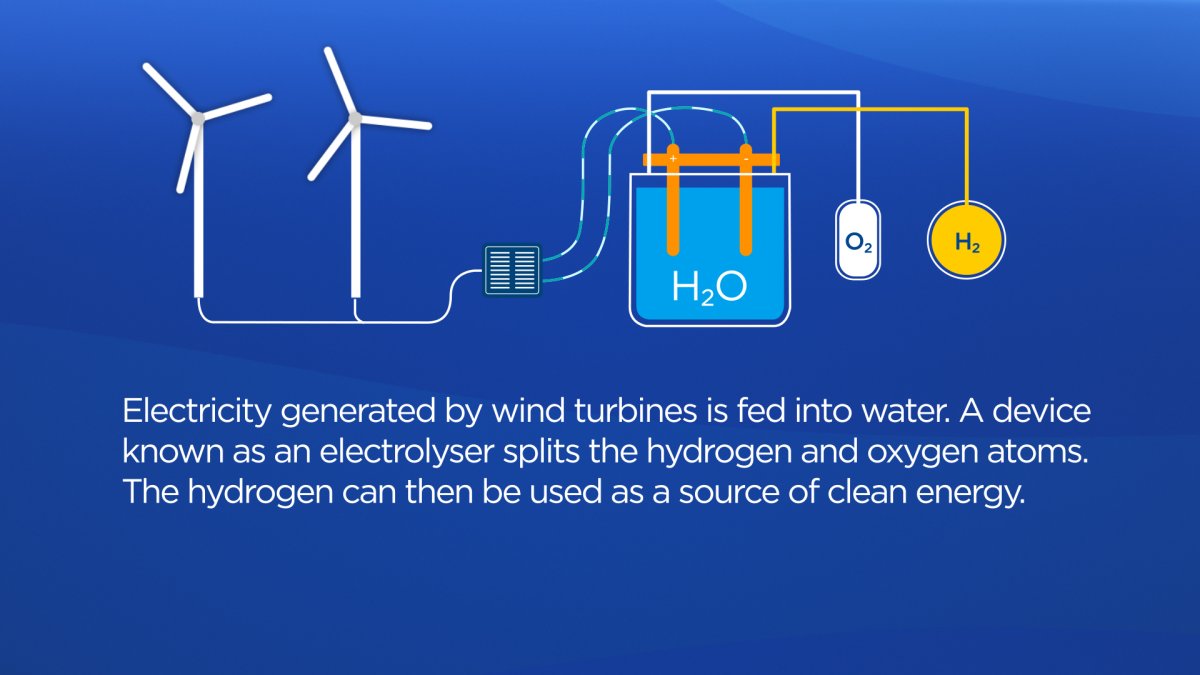This week, Canada signed onto a major energy project with Germany that, once built, will transform the windswept Port au Port Peninsula in Western Newfoundland and Labrador into a hydrogen-producing energy powerhouse.

The first phase of the project involves building 164 new wind turbines in one of the windiest corners of the country. The idea is to use the renewable power generated from those wind turbines to produce what’s known as ‘green’ hydrogen, which can then be shipped to Germany to address that country’s growing energy security fears.
Federal Natural Resources Minister Jonathan Wilkinson says the massive wind-to-hydrogen project is in direct response to Russia’s war in Ukraine, a geopolitical crisis that has spurred Germany, long dependent on Russian energy imports, to look for other sources of energy beyond what the Kremlin is willing to supply.
That’s where Canada, and Western Newfoundland with its wind resources, come in.
The Canadian hydrogen market is currently worth about $6 billion per year, and Canada is one of the world’s top ten producers of this valuable element. The biggest hydrogen makers are oil companies. But now, wind energy is about to enter into the fray, to tap into an export market that’s set to grow.
“I would think that green hydrogen could play an important role in the future, but combined with other solutions, to decrease our dependence on fossil fuels and decrease greenhouse gas emissions,” said Clémence Fauteux-Lefebvre, an engineering professor at the University of Ottawa, in an email to Global News.
But what is hydrogen, how can it be ‘made’ from wind, and can it really be ‘green’?
What is hydrogen?
Hydrogen is the most abundant element in the universe. It’s everywhere, including in almost all living creatures on Earth.
But as a standalone chemical element, hydrogen isn’t found freely in nature. That’s because hydrogen is very reactive, which means its atoms tend to bond quickly with atoms of other elements. The most common element hydrogen gloms onto is oxygen. Two hydrogen atoms plus one oxygen atom, H₂O, is the chemical composition of water.
The abundance of hydrogen and the fact that it isn’t found freely in nature represents both an opportunity and a challenge for hydrogen as a fuel source of the future.
There’s a lot of it out there, but unlike fossil fuels, which you can just dig out of the ground and burn to produce energy, hydrogen needs to be made – by pulling it ‘away’ from other chemical elements, notably oxygen.
“Hydrogen is kind of like electricity,” says Keith Wipke, an energy expert at the National Renewable Energy Lab in Colorado, a group that works on improving hydrogen technology. Much like electricity has to be generated from something, hydrogen, too, has to be produced, and the most common and affordable way for that to happen is by converting fossil fuels, usually natural gas, but also coal.
How is hydrogen produced?
The most common process for producing hydrogen is known as “steam-methane reforming.” In this process, natural gas, which contains methane (a combination of four hydrogen molecules and one carbon molecule), is combined with steam. This breaks the hydrogen molecules off of the methane, creating what’s known as ‘grey’ hydrogen, the cheapest form of hydrogen to produce.
But separating hydrogen from methane requires energy, and, until now, the most cost-efficient way of producing that energy was to burn fossil fuels.
The vast majority of the world’s hydrogen is produced by burning fossil fuels, which release carbon dioxide, the main culprit in global warming, into the atmosphere.
In other words, this ‘clean’ fuel of the future isn’t really all that clean at all.
Enter… the power of the wind.
Can hydrogen be produced ‘cleanly’?
There are at least two ways to reduce the carbon emissions footprint of hydrogen. One way is to literally bury the CO2 emissions from burning the fossil fuels that are needed to produce hydrogen.
“If you take the CO2 that’s formed (from producing hydrogen) and you concentrate it and inject it underground, that’s generally what’s called ‘blue’ hydrogen,” explains Murray Thomson, a professor in the Department of Mechanical and Industrial Engineering at the University of Toronto, and the Chief Science Officer at Aurora Hydrogen.
The other option is what is known as electrolysis, which involves running an electrical current through water. That’s the process that will be used in the Newfoundland and Labrador wind-to-hydrogen project. To produce hydrogen using electrolysis, water is ‘split’ – literally by pulling the two hydrogen atoms in H₂O away from the lone oxygen atom. This ‘isolates’ the hydrogen so that it can then be used as a fuel source.
But the process of electrolysis, Thomson says, also uses a tremendous amount of energy – a lot more than the conventional route of using natural gas and steam. But since the electricity that is run through the water to produce hydrogen can be generated using wind or solar, theoretically this is a less emissions-intensive approach.
Amit Kumar, a professor of mechanical engineering at the University of Alberta, says the cost of producing hydrogen by using wind energy “is three to four fold higher” than producing hydrogen from natural gas and then burying the CO2 emissions underground.
(There’s also the reality of shipping it across the Atlantic. Hydrogen is highly flammable and difficult to store, much less ship across an ocean. Either it needs to be cooled down and turned into a liquid, or converted into ammonia, which can be shipped to Europe and used as a replacement for natural gas, or converted back to hydrogen).
On the flip side, Kumar says, using wind energy to produce hydrogen, as energy-intensive as that is, still produces far less CO2 overall, which is why ‘green’ hydrogen is touted as the clean energy fuel of the future.
And the Port au Port peninsula in Newfoundland has a lot of wind. In fact, it’s constantly windy.
“The availability and the competitiveness of wind in (Newfoundland and Labrador) is exceptional,” says Christopher Jackson, who runs a group called Protium, based in the United Kingdom, which supports the development of green hydrogen. “It’s one of the most exceptional resource environments for wind in the world.”
Given that the current ways of producing hydrogen produce as much CO2 as the annual emissions of the United Kingdom and Indonesia put together, Jackson says there’s a huge opportunity to ‘go green’ with this potent source of energy.
‘Filling up’ with hydrogen?
Despite all the excitement, hydrogen still hasn’t risen to the occasion in a lot of everyday applications.
For decades, this abundant element has been eyed as a potential clean fuel alternative to gasoline. When used to power a vehicle, the only thing emitted from the car’s tailpipe is water, clean enough to drink.
So why has hydrogen failed to displace the internal combustion engine, much less compete with EVs powered by batteries?
The reason is that unlike fossil fuels, which can be burned directly to produce energy, hydrogen needs to first be converted into energy in a car. (Because hydrogen is very flammable, if it is just burned, it will quickly go up in flames – think the Hindenburg).
Tapping into the power of hydrogen requires what’s known as a fuel cell – a device that converts hydrogen into electricity which then powers the car.
This process, however, results in a lot of energy loss … around 60 per cent. It’s far more efficient to use a lithium battery to produce the electricity that then generates the kinetic energy to move your car – which is why EVs have surpassed hydrogen as the method of choice for making zero-emission cars.
Where hydrogen makes the most sense is when batteries simply can’t cut it – think powering trucks, trains, even airplanes, as airplane manufacturer Airbus is doing with some hydrogen-fuelled prototypes.
Hydrogen is an incredibly energy-dense fuel. That means it packs far more punch in the same amount of space as a battery. Powering a truck carrying an 80-thousand pound load with a battery, for example, would require a battery that would be almost the size of the truck itself. But a hydrogen cell could easily move a bus, a truck or even an airplane, in ways that a battery would not be able to, at least not without constantly having to be recharged.
The other advantage to hydrogen is that refilling can take place in a fraction of the time it would take to charge a battery.
“Hydrogen’s strength is in its energy density and ease of filling,” Professor Thomson says. “I think the first, or the most attractive hydrogen applications will be heavy duty (vehicles).” These include heavy duty trucks going on long distances, mining vehicles, trains, and even aircraft. Steel manufacturing, which is also very energy-intensive, can also benefit hugely from hydrogen as an energy source.
“None of these transformations are going to happen overnight, but if we work steadily at them, big changes can happen.”
Hydrogen gold rush
Despite the promise of hydrogen, not everyone is jumping onto the hydrogen bandwagon.
Back in Newfoundland, residents of Stephenville, where a consortium led by renewables giant World Energy GH2 wants to build the wind-to-hydrogen project, worry what a massive increase in the number of windmills will do to their picturesque peninsula.
Nick Mercer, a postdoctoral researcher at Dalhousie University who calls Stephenville home, is worried how a province that’s still relatively new to wind energy can install dozens upon dozens of turbines in such short order. (The groups behind the project are hoping to have the first shipments to Europe begin by 2025).
“This is a mega project and it’s going to have mega impacts,” he says. “If you look at the map (of the project) it looks like a game of Battleship – the entire peninsula is being turned into a wind farm.”
Another concern, he says, is the fact that Newfoundland and Labrador hasn’t exactly had a great track record with other renewable energy mega-projects, pointing to the boondoggle that’s been the Muskrat Falls hydroelectric project.
He wonders why the energy produced from all that valuable wind power wouldn’t be used to generate electricity – which can be used to power everything from homes to EVs – instead of using those precious renewable energy resources in a highly-intensive process to create ‘green’ hydrogen that then gets shipped across the Atlantic using yet more energy-intensive processes.
Still, opposing a clean energy project is a dilemma, he says, because as a renewable energy researcher, he wants to see Canada rapidly wean itself off fossil fuels.
He says it comes down to ownership and control of such projects being in the hands of local communities, including First Nations. Instead, he fears, Newfoundland and Labrador’s resources are being sold off to private-sector corporations and “billionaires” that have no “social license” to tap into that wealth.
That, he says, is unacceptable, and is the paradox of the clean energy revolution.
“I’m not ready for that form of development.”







Comments